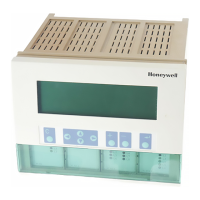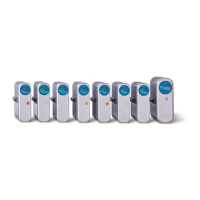EXCEL CARE CONTROL ICONS ALPHABETIC REFERENCE
113 74-5577–33 (US)
EN2B-0184 GE51 R0518 (Europe)
(Shutdown) XFM 35 determines when immediate shutdown is necessary (see General
Functions in the XFM 35 section) and sets user address ID___Shutdown to 1 to
command all XFM 36-1/S/Rs to immediately shed their loads.
When an XFM 36-1/S/R reads a 1 value in ID___Shutdown, it switches off its load,
regardless of minimum ON time.
After the shutdown command is over (ID___Shutdown = 0), each XFM 36-1/S/R
must again receive a positive power value at its Po input before its load is turned
ON.
Start-up after a Power Failure Start-up action after a power failure depends on the type of algorithm in use.
If the Sliding Window algorithm is being used (as described in the XFM 35
section), power calculation continues after the power returns as if there were no
interruption. XFM 35 starts to switch ON the loads again as if the power demand
program was starting for the first time.
If using the Ideal Curve or Extrapolation algorithms (described in the XFM 35
section), the power calculations are reset and restarted as if the whole system has
its first start-up. After the power returns, XFM 36-1/S/R receives a shutdown
message from XFM 35 (ID___Shutdown = 1) and immediately switches off the
load (see General Functions in the XFM 35 section). After the shutdown command
is over (ID___Shutdown = 0), each XFM 36-1/S/R must again receive a positive
power value at its Po input before its load is turned on.
XFM 36-1 Priority Group Assignment
A maximum of 50 XFM 36-1s, 36-1Ss and 36-1Rs can connect to one another in a
group. XFM 36-1s, 36-1Ss and 36-1Rs connect to one another via the Po inputs and
outputs. In other words, the Po output of one XFM 36-1/S/R is the input to another
XFM 36-1/S/R.
You assign a group of XFM 36-1/S/Rs to a priority group by selecting XFM 35 input
Po1, Po2, or Po3 as the recipient of the Po output from the last (lowest load
number) XFM 36-1 in the group and the corresponding XFM 35 Po output as the
input to the Po of the first (highest load number) XFM 36-1 of the group. For
example, if you select the Po2 input and output of the XFM 35, the group becomes
Priority Group 2.
XFM 36-1/S/R Switching Behavior
The Po corrections carry the power values that each XFM 36-1/S/R uses to
change the status of its load (ON or OFF). A positive power value switches on
(restores) the load; a negative value switches it off (sheds it).
Several conditions in addition to the Po value (the first input) determine the final
command (ON/OFF) to the load output St. The command is sent to the first output
St of XFM 36-1/S/R. These conditions are explained in the following sections,
including the General Functions section.
XFM 36-1/S Sequential Load Switching
In the sequential mode, each load in a priority group has a fixed rank. Low-ranking
loads are shed first while high-ranking loads are shed last. Load 1 is the highest
ranking load and is shed last and restored first. The highest load number is the
lowest rank. It is shed first and restored last.
The following drawing shows how a group of seven loads responds to restore and
shed commands.

